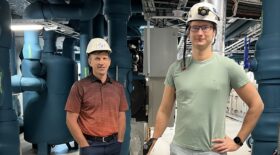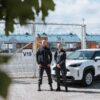Koda Ehitus, a company in the Forus Group, is taking on increasingly challenging projects: this year, the North Estonia Medical Centre received one of the most modern cooling systems.

This year, the Y-block, which has an area of approximately 14,500 square metres, was opened at the North Estonia Medical Centre (PERH). The block houses a state-of-the-art cancer treatment facility. Koda Ehitus contributed to the construction of the new building and was entrusted with the development of the most modern cooling system that would comply with very strict requirements for the hospital. This is essential for the operation of such an important building.
For us, work at the medical centre began before the coronavirus crisis for us. Now, the work in the Y-block is complete and the new building has been open for patient care for some time now.
Very strict requirements
In hospitals, the main objective of cooling is to prevent the room temperature from rising above the permitted value as well as dissipating the excess heat from various devices. In addition to providing people with a comfortable room temperature, the cooling system also helps to remove the excess heat from medical devices required for treatment.
This is why, for example, Koda Ehitus installed external coolers (dry-coolers), which are a part of the cooling system, on the roof of the Y-block. Their job is to expel excess heat from the building.
Joonas Kosk, the project manager of Koda Ehitus, considers the North Estonia Medical Centre one of the most complicated, but also the most interesting projects he has managed. This is mainly because a hospital as a building has very strict requirements for construction, because people’s lives and health are at stake.
‘The systems must work perfectly. If, for example, the cooling system stops on a hot day in a shopping centre, customers complain and feel uncomfortable, but it is likely that there is no immediate danger to anyone’s health. If the cooling system stops working in a hospital, treatment stalls, which is a direct threat to people’s lives,’ says Kosk.
This is why critical systems are duplicated in hospitals, allowing for different backup plans to be used during accidents or maintenance operations. Everything has been thought of and all possible scenarios tested.
If one cooling unit breaks down, the others will cover the entire cooling demand. Generators are switched on in the event of a power outage, which also ensures the operation of the cooling equipment. In the worst-case scenario, the most critical systems can even be cooled with water from the mains. However, if something happens to the automated systems responsible for cooling, different systems can be manually switched on.
‘This type of duplication of systems is an absolutely basic requirement in hospitals. However, that is not the case for ordinary office buildings, as it is simply very expensive,’ says Kosk.
The automated systems have the most important role in ensuring reliability, monitoring for anything going wrong or for any system malfunctions in real time. These systems always make the first necessary switches. Human intervention is needed only when all other systems fail.
Lack of competence in Estonia
The basement floor of the new building also houses a modern magnetic resonance imaging (MRI) centre. To ensure the reliability of the machines, it is necessary to maintain a very precise temperature and level of humidity. MRI equipment is of critical importance in hospitals, so the systems necessary for its operation are also duplicated.
These systems are very complex in terms of engineering and there are few companies that are involved in building such complex cooling systems in Estonia. One of them is Koda Ehitus.
Üllar Aun, CEO of Koda Ehitus, admits that one of their great strengths is a professional technical team and very good project managers who are able to make full use of the team’s capabilities.
‘We have a lot of other work in progress and the team has gained a great experience. This gives us confidence to accept very complicated and challenging projects in the future,’ finds Aun.
Proper care
It took eight kilometres of pipes to build the cooling system for the Y-block, which is designed to collect thermal energy throughout the building.
Proper maintenance is essential for ensuring the reliability and sustainability of the systems. The average life expectancy of cooling is 20 years. It is possible to extend the life span with proper maintenance, but it is important to bear in mind that the manufacturers of technical equipment invest heavily in development. This means that in 20 years, today’s state-of-the-art technologies will be outdated and much more efficient and better equipment will have been developed, and in some cases, it would be wise to replace the base equipment with newer versions.
As Merko Ehitus was responsible for the construction of the Y-block.
Koda Ehitus, part of Forus Group, offers services related to the design, construction, and maintenance of special components of the building, such as ventilation, automation, cooling, and heating systems.
Several major projects are currently underway. For example, ventilation works are being carried out at the Tallinn City Theatre in the Old Town. Work is also ongoing in the Kumu Art Museum in Kadriorg, where the Forus team is taking care of the renovation of the irrigation system.


